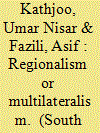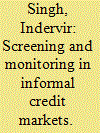|
|
|
Sort Order |
|
|
|
Items / Page
|
|
|
|
|
|
|
| Srl | Item |
| 1 |
ID:
187132


|
|
|
|
|
| Summary/Abstract |
Based upon a sample of 78 firms operating in Indian automotive component industry for the period 2000–2018, this research empirically examines the role of business-group affiliation, overseas investment and technology in determining exports. It applies panel Tobit and Probit model estimated with the maximum likelihood estimator. This research finds that technology imports, firm’s age, overseas investment and affiliation to a business group significantly affect industry’s export performance. However, some variables, such as past R&D intensity, firm’s size and companies with overseas investment and being part of a group have been found to have had a detrimental effect. All these results show that being outward-oriented in terms of overseas investment and being affiliated with a business group makes a significant difference concerning export success.
|
|
|
|
|
|
|
|
|
|
|
|
|
|
|
|
| 2 |
ID:
187134


|
|
|
|
|
| Summary/Abstract |
In Bangladesh, despite increased participation in the labour market in recent decades, women are still lagging behind men by a significant margin, with the former being concentrated chiefly in low-paid agriculture as well as in the lower stages of the occupational ladder. With the help of the latest labour market data of 2016–2017 coupled with 2011 census data, this article attempts to examine gender segregation through sectoral and occupational lenses. Our econometric estimation of different sectors (agriculture, manufacturing, construction and service) reflects the importance of gender-centric factors such as care burden and marital status along with local employment opportunities in constraining women’s labour market engagement. Besides, decomposition analysis highlights that unfavourable returns to endowments play a crucial role in females’ concentration in relatively low-productive sectors. Sectoral and occupational segregation indices reflect a high degree of segregation between men and women. Thus, against the backdrop of the concentration of women in low-skilled jobs and a low-productive sector, this article expects to provide important policy insights for boosting female employment in relatively high-productive sectors and high-paid occupations while utilizing the structural shift in the labour market of Bangladesh.
|
|
|
|
|
|
|
|
|
|
|
|
|
|
|
|
| 3 |
ID:
187133


|
|
|
|
|
| Summary/Abstract |
The presence of private providers in the Indian healthcare sector remains one of the most debated issues. This article attempts to contribute to this debate from the angle of the ultimate goal of healthcare provision—a healthy population. We explore whether private sector presence (PSP) has improved the general health status of the people. We develop a theoretical argument to hypothesize that PSP in India would lead to better health status through the route of competition-driven quality, which in turn could lead to adverse economic consequences. We use district-level secondary data from government sources to confirm our hypotheses using robust tools of applied econometrics, correcting for serious problems of endogeneity. Constructing a district-level index of PSP, we identify distinct spatial/geographical clusters, explained by socio-economic prosperity as well as demonstration effect. We also find a robust positive association between PSP and general health outcomes, accompanied by an adverse economic consequence of rising catastrophic out-of-pocket expenditure. In terms of policy, the article concludes that rather than restricting the growth of the private sector, the government must strengthen the quality of the existing public healthcare delivery system and ensure effective monitoring and regulation.
|
|
|
|
|
|
|
|
|
|
|
|
|
|
|
|
| 4 |
ID:
187131


|
|
|
|
|
| Summary/Abstract |
With an impasse at Doha round of negotiations, many countries started to change their course of economic liberalization from generic policies of multilateralism to regional trade agreements (RTAs). In this scenario, India plausibly lacks the presence and will of concluding such agreements with some of its major trading partners while being sceptical about the existing ones. Using structural gravity, this study has quantified the impact of country-specific globalization levels and RTAs on international trade among India and its 32 major trading partners. Unlike a plethora of studies employing the gravity model on Indian trade policy issues, we have made use of many recent advancements in gravity modelling. Our methodology robust to the use of intra-national trade data, two alternative estimators, and multiple scenarios naturally addresses the endogeneity issues that are prominent with trade policy variables like RTAs. The empirical results reveal that RTAs have a comparatively strong impact in promoting trade among sample countries. However, country-specific globalization levels measured by the KOF globalization index have a very negligible impact on promoting trade among sample countries. Furthermore, we have obtained very slight asymmetries across the impact of country-specific globalization levels on exports versus imports of mid-income countries with high-income countries.
|
|
|
|
|
|
|
|
|
|
|
|
|
|
|
|
| 5 |
ID:
187135


|
|
|
|
|
| Summary/Abstract |
The present article examines the screening and monitoring strategies used by lenders to solve the problem of imperfect information in the rural informal credit market. The study uses data from a primary survey conducted in Punjab, India. The survey focuses on informal lending between commission agents and farmers. Data were collected from 120 randomly selected commission agents from four blocks. Each of the blocks represents a different development level. The results show that commission agents invested significant time and resources for screening and monitoring the farmers. The screening and monitoring were found to be more stringent in areas that were underdeveloped and had higher default risk. Commission agents could shift a significant share of the screening cost to the borrowers, thereby increasing their self-enforcement range. The study argues that high screening cost hurts small farmers. The regression results found a significant reduction in the default rate and the unrecovered loan due to screening strategies.
|
|
|
|
|
|
|
|
|
|
|
|
|
|
|
|
|
|
|
|
|